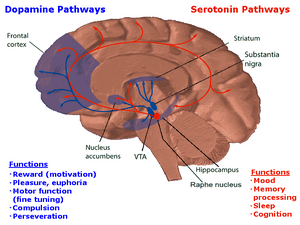
The Mesolimbic Reward Pathway[]
The mesolimbic reward pathway is one of four dopaminergic pathways in the brain. This pathway originates in the ventral tegmental area and projects to the limbic areas including the nucleus accumbens (NA), amygdala, thalamus, hypothalamus and the hippocampus and continues to the prefrontal cortex (Babylon.com).
The group of neurons at the center of the brain is known as the ventral tegmental area (VTA). This area plays a very important role in the reward circuit. Regions around the brain relay messages to the VTA telling it how well various fundamental and more importantly human needs (only active when paired with reinforcing stimuli) are being satisfied. After these messages are received, they are then forwarded to a structure further forward in the brain known as the nucleus accumbens (NA) using a particular chemical called dopamine (thebrain.mcgill). Now, what happens when opiates or any addictive stimulus are introduced into the VTA? It sets off a reaction in the VTA that increases dopaminergic cell firing, which subsequently increases of dopamine in the NA. It is said that Beta-endorphins and opiate drugs seem to increase VTA firing by inhibiting the GABA inhibitory cells found in the VTA. By opening K+ channels or reducing Ca2+ influx on GABA terminals can cause a decrease release of GABA, and due to this inhibition of inhibitory neurons, it can lead to an increase of firing and greater release of DA in the NA. With that said, an increase of dopamine in the nucleus accumbens triggers or reinforces behaviors that in turn satisfies individuals needs..
Sources[]
- "Mesolimbic reward pathway". Babylon.com. November 28, 2009 <http://www.babylon.com/definition/mesolimbic_reward_pathway/>.
- Nestler, E., & Malenka, R. (2004). The Addicted BRAIN. Scientific American, 290(3), 78-85. http://search.ebscohost.com.libproxy.gc.maricopa.edu
- "The pleasure centres". Canadian Institute of Neurosciences, Mental Health, & Addiction. November 28, 2009 <http://thebrain.mcgill.ca/flash/d/d_03/d_03_cr/d_03_cr_que/d_03_cr_que.html>.